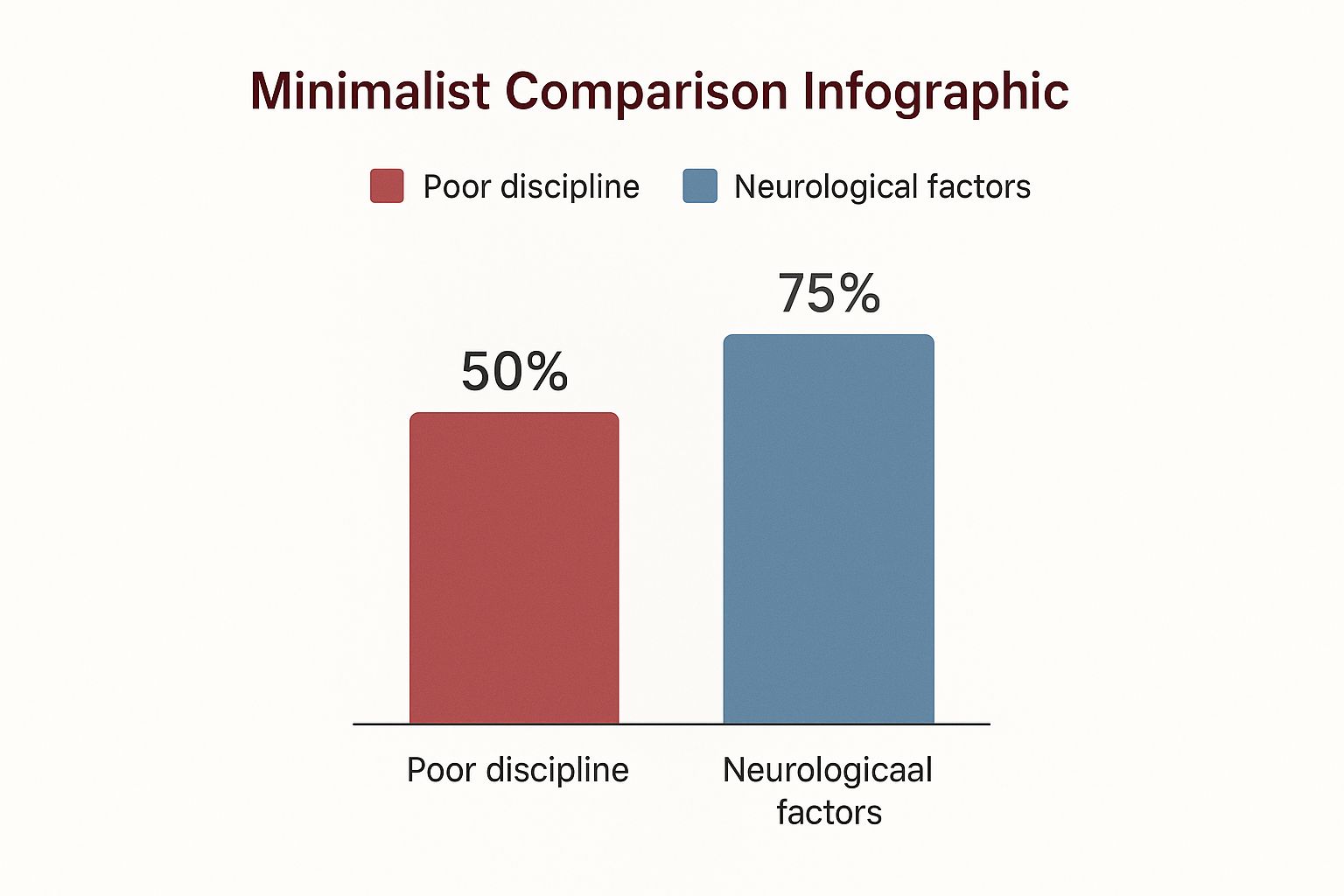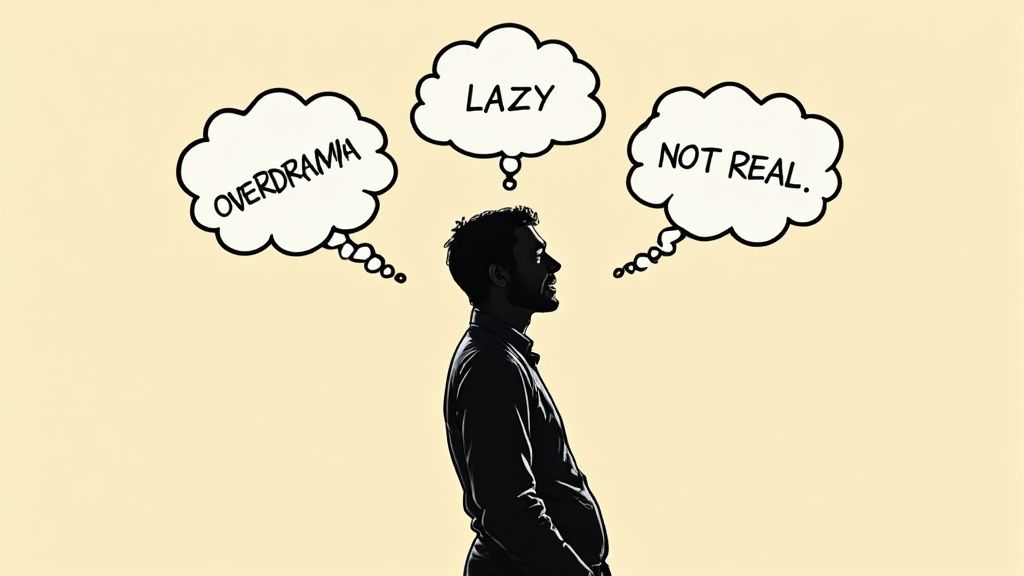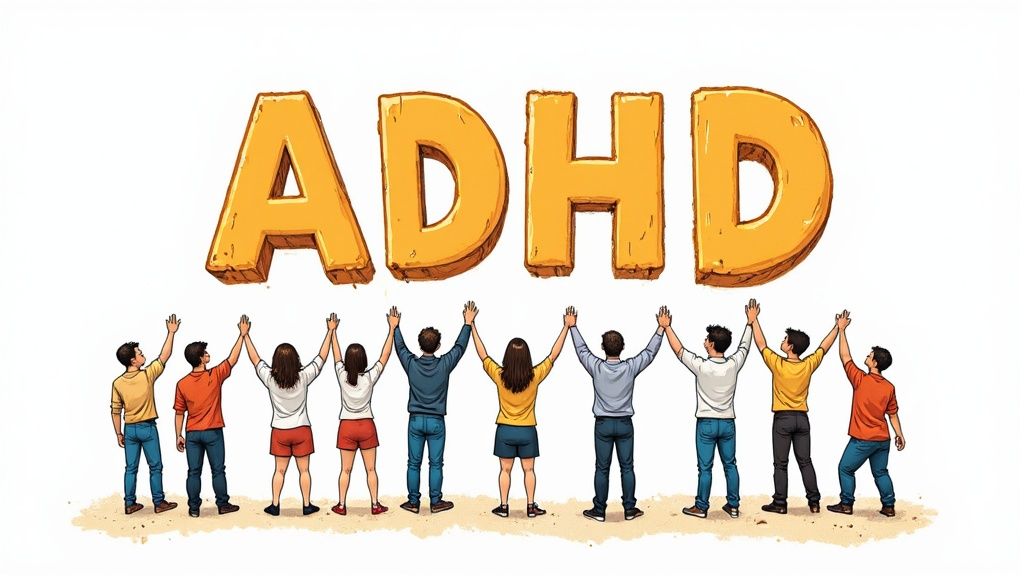ADHD stigma is the painful social penalty people face because of widespread myths about their neurodevelopmental condition. This often shows up as judgment, dismissal, and harmful stereotypes—like being called lazy or undisciplined. For many, this stigma can be even more damaging than the ADHD symptoms themselves.
The Hidden Burden of ADHD Stigma
Imagine you're trying to drive on a busy highway, but your car is built a bit differently. It's incredibly fast and creative, but the steering is extra sensitive and the brakes don't always respond when you expect them to. While you're intensely focused on just keeping the car on the road, other drivers only see you swerving and assume you're just being reckless.
This is what living with ADHD stigma feels like every single day. It’s not just a simple misunderstanding; it’s a heavy weight that stops people from getting help and living their lives to the fullest.
These harmful stereotypes create real-world problems. The belief that ADHD is just a childhood phase, an excuse for laziness, or a sign of weak willpower leaves people feeling isolated and invalidated. This constant judgment piles a thick layer of shame and self-doubt on top of the already difficult job of managing executive functions.
The Global Impact of Misconceptions
The fallout from this stigma is massive and damaging. It's a major roadblock to diagnosis and treatment all over the world. An estimated 404 million adults globally have ADHD, but a huge number of them are never diagnosed, often because they’re afraid of being labeled or judged.
Stigma doesn't just hurt feelings; it actively prevents access to care. When society mischaracterizes a neurological condition as a character flaw, it discourages individuals from seeking the very support that could transform their lives.
In the United States alone, roughly 16.13 million adults are living with ADHD. More than half of them weren't diagnosed until they were adults, a telling statistic that speaks to decades of historical stigma and a lack of recognition. This delay means years of needless struggle that could have been eased with proper support and understanding. You can explore more about these statistics and their implications to grasp the true scale of the issue.
Tracing the Roots of Common ADHD Myths
To really get a handle on ADHD stigma, we have to dig into where it all started. These stubborn myths didn't just pop up overnight. They’re tangled up in a long history of misunderstanding, old-fashioned social expectations, and overly simplistic media stories that have colored how people see ADHD for decades.
A lot of these ideas got their start back when ADHD, or conditions like it, were first being described. Without the brain imaging tools we have today, early theories often pointed to a child's character, lack of willpower, or their upbringing as the cause, rather than seeing it for what it is: a difference in brain function. This laid a foundation of blame that, unfortunately, still sticks around.
The belief that ADHD is some kind of moral failing instead of a neurological condition is one of the most damaging parts of its history. It’s a perspective that fuels shame and stops people from getting the help they truly deserve.
The Myth of Choice vs. The Reality of Brain Science
One of the stickiest myths out there is that ADHD symptoms are a choice—a simple failure of discipline. That’s like telling someone who needs glasses to just squint harder. It completely misses the point.
Brain imaging studies have shown us, time and again, that there are real structural and functional differences in the brains of people with ADHD. These differences are especially noticeable in the areas that manage our executive functions, like attention, impulse control, and keeping our emotions in check.
This infographic shows just how far public opinion lags behind what the science tells us.
The gap is pretty stark. While 75% of the evidence points to neurological causes, 50% of people still think it comes down to poor discipline. This mismatch is a huge source of stigma.
How Media and Public Conversations Shape Perceptions
The media has a massive influence on these outdated ideas. Sure, there’s more talk about ADHD than ever before, but not all of it helps. Between 2014 and 2024, the number of media articles on ADHD jumped from about 5,700 to over 25,000.
Some of the most visible stories have zeroed in on claims of overdiagnosis. This kind of reporting can make people question if the condition is even real, adding to the stigma while often ignoring the serious risks of leaving ADHD untreated. You can read more about how media influences ADHD stigma to get a fuller picture of the problem.
This constant flood of mixed messages creates a confusing environment where myths are often treated like facts. To help clear things up, let's look at some of the most common myths side-by-side with the scientific reality.
Common ADHD Myths vs. Scientific Reality
| Common Myth | Scientific Reality |
|---|---|
| "ADHD isn't real. It's just an excuse for bad behavior or laziness." | ADHD is a recognized neurodevelopmental disorder with a strong biological basis, confirmed by decades of research and brain imaging studies. |
| "People with ADHD just need to try harder to focus." | The issue isn't a lack of effort. ADHD affects the brain's executive functions, making it physically harder to regulate attention and control impulses. |
| "Only hyperactive little boys have ADHD." | ADHD affects people of all ages, genders, and backgrounds. In girls and women, it often presents as inattentiveness rather than hyperactivity, leading to underdiagnosis. |
| "ADHD is caused by bad parenting or too much sugar." | While environment can influence symptoms, research strongly indicates that ADHD is primarily genetic and neurological. Diet is not a root cause. |
| "Medication is a crutch and creates 'zombies'." | For many, medication is a highly effective tool that helps manage core symptoms. When prescribed and monitored correctly, it helps individuals function better, not turn them into zombies. |
| "You can't have ADHD if you can hyperfocus on video games." | Hyperfocus is a hallmark of ADHD. The brain can lock onto high-stimulation, high-reward activities while struggling with less engaging, but necessary, tasks. |
Breaking down these myths is so important because they aren't just harmless opinions. They have a real impact, leading to internalized shame and acting as a barrier that keeps people from getting support that could change their lives.
Recognizing that these symptoms are not character flaws is the first, most important step. It's a key part of therapeutic work, where individuals learn to reframe these damaging, internalized beliefs. For those looking for ways to do this, learning how CBT for ADD and ADHD helps people challenge and change these negative thought patterns can be a great place to start. Once we understand where these myths come from, we’re much better prepared to take them apart with facts, empathy, and understanding.
The Real-World Impact of Stigma on Life and Health
The pervasive myths around ADHD aren't just hurtful—they cause real, measurable harm. When ADHD stigma stops someone from getting a diagnosis or finding support, the consequences ripple through every corner of their life. We're talking about everything from physical health and mental well-being to professional opportunities and even lifespan.
This isn't an exaggeration. It’s a public health reality. The weight of constant judgment and misunderstanding makes it incredibly difficult for people to manage their symptoms. Imagine trying to build a career or hold onto meaningful relationships while also fighting an internal monologue of shame fueled by outside criticism. It's exhausting.
The Connection Between Delayed Diagnosis and Adverse Outcomes
One of the most dangerous consequences of stigma is when it causes someone to delay or completely avoid a diagnosis. The struggles that come with untreated ADHD—like forgetfulness or difficulty with follow-through—are often chalked up to personal failings. People get labeled as lazy, irresponsible, or careless.
This misjudgment blocks access to interventions that aren't just helpful, but truly life-saving.
The impact is stark. Research shows that undiagnosed and untreated ADHD can shorten a person’s life expectancy by an average of 7.5 years. This isn't just a number; it represents higher risks of fatal accidents, chronic job instability, and the development of severe co-occurring mental health conditions.
The good news? Effective treatment completely changes this outlook. For example, medication has been shown to reduce the overall risk of premature death by 19% and cut the risk of substance abuse in half. You can learn more about how treatment impacts these critical health outcomes.
Stigma acts as a barrier to care, and the lack of care has devastating effects. The narrative that ADHD isn't serious overlooks the profound physical and emotional toll it takes when left unsupported.
How Stigma Exacerbates Mental and Emotional Health Challenges
Beyond the physical risks, ADHD stigma is a relentless assault on a person's mental health. When you live in a world that constantly misunderstands how your brain is wired, it's no surprise that other conditions often develop alongside it.
Anxiety and depression are especially common travel companions for those with ADHD, and stigma is a huge reason why. The emotional toll of being constantly criticized or feeling like you can never measure up creates the perfect breeding ground for these disorders to take root.
Think about these common scenarios, which are made so much worse by stigma:
- The Professional Setback: An employee misses a deadline because of executive function challenges. Instead of getting support or an accommodation, they're labeled "unreliable." They get passed over for a promotion and start to internalize a deep sense of failure at work.
- The Social Strain: A friend struggles with emotional dysregulation and impulsively says something hurtful. Rather than their friends understanding this as a symptom, they pull away. This leads to intense social isolation and reinforces the feeling of being "broken" or unlikable.
These aren't just one-off incidents. They are recurring patterns that slowly chip away at a person's self-worth. They show how systemic misunderstanding—not a personal flaw—is what often drives the most painful struggles.
Fighting ADHD stigma isn't just about being kind. It's about removing a fundamental obstacle to health, safety, and the chance to live a full life.
How Internalized Stigma Shapes Self-Perception
The most damaging part of ADHD stigma isn't what happens on the outside—it’s what happens when those negative messages find their way inside your head. When you spend years absorbing criticism, dismissals, and stereotypes, it can completely warp how you see yourself. This is known as internalized stigma, and it’s like a quiet poison to your self-worth.
Think about hearing subtle (and not-so-subtle) jabs your entire life: "You're just not trying," "Why are you so sensitive?" or the classic, "You have so much potential if you'd just apply yourself." After a while, you stop hearing these as outside opinions and start believing they are fundamental truths about who you are.
This constant inner monologue is the perfect breeding ground for chronic self-doubt, crippling shame, and a powerful sense of being an imposter. It's the reason a highly successful professional with ADHD can land a huge client and still feel like a total fraud, just waiting to be exposed.
The Voice of Imposter Syndrome
That internal critic doesn't just question what you can do; it actively dismisses what you've already done. It whispers that your accomplishments were just luck, a mistake, or someone else's doing—never your own merit. This feeling can be especially sharp given the day-to-day variability of ADHD symptoms.
For example, a parent with ADHD might have a fantastic week—they're organized, loving, and on top of everything. But the second they forget a permission slip or lose their patience, that internalized stigma comes roaring back, telling them they're a failure as a parent. These feelings aren't a reflection of reality, but a distorted echo of society's judgment.
The greatest trick stigma plays is convincing you that its voice is your own. Recognizing that the harsh inner critic is often just parroting external bias is the first step toward reclaiming your self-perception.
Rejection and Emotional Sensitivity
This internal battle is deeply tied to Rejection Sensitive Dysphoria (RSD), which is an intense emotional pain that flares up in response to perceived or real rejection. Living in a world that consistently misunderstands and penalizes ADHD traits means you're likely facing more social friction, criticism, and perceived failures than most.
Each of these moments can reinforce the core belief that something is just plain wrong with you. It can make navigating social situations feel like walking through a minefield, where any misstep could trigger an overwhelming wave of shame. Understanding how this connects to impulsivity is key. You can learn more about managing ADHD impulsivity and who’s driving the boat to get a better handle on this dynamic.
Here’s the main takeaway: The self-doubt, the shame, and the feeling of being an imposter are not proof that you're inadequate. They are the painful, but predictable, symptoms of living with a misunderstood condition in a world that often isn't very forgiving.
Actionable Strategies to Reduce ADHD Stigma
Knowing where ADHD stigma comes from is one thing, but actually dismantling it takes conscious, consistent effort. The good news is that real change doesn’t require grand, sweeping gestures. It’s built through the small, everyday choices we all make—individuals with ADHD, their friends and family, teachers, and employers.
Think of it like tending a community garden. One person pulling a few weeds makes a small difference, but when everyone pitches in—watering, planting, and protecting—the whole garden thrives. These strategies are your tools to start cultivating a more accepting and understanding environment.
For Individuals with ADHD: Taking Control of Your Narrative
If you have ADHD, pushing back against stigma often starts with self-advocacy and setting healthy boundaries. It’s about taking back the pen and writing your own story, rather than letting misconceptions define you.
- Practice Strategic Disclosure: You don't owe anyone an explanation. You get to decide when, where, and with whom you share your diagnosis. Sometimes it’s more powerful to advocate for your needs without even using the "ADHD" label. For example, instead of disclosing, you could simply say, “I concentrate best when I have instructions in writing.”
- Reframe Your Inner Dialogue: Pay attention to how you talk to yourself. Instead of falling into self-criticism like, "I'm so lazy," try a more objective observation: "I'm having a hard time getting started on this." This simple shift separates your identity from your symptoms, which is a huge step in fighting internalized stigma.
- Build Your Support System: Find your people. Connecting with other neurodivergent individuals, whether in online forums or local groups, is incredibly validating. It’s a powerful reminder that you aren't alone and provides a much-needed buffer against a world that can often feel isolating.
Finding the right professional support can also be a game-changer. Learning more about different approaches to adult ADD and ADHD treatment can equip you with personalized strategies to manage your symptoms and build resilience.
For Allies and Supporters: How to Foster Acceptance
If you don't have ADHD, your words and actions have more power than you might think. You can either reinforce damaging myths or help create a space where people feel safe enough to be themselves.
True allyship isn't just about passive tolerance. It's about actively working to make your corner of the world more inclusive. It means listening, learning, and using your position to advocate for understanding and accommodation.
Here are a few simple but powerful ways you can be a better ally:
- Gently Correct Misinformation: When you hear someone repeat a common ADHD myth, offer a gentle correction. A simple, "Actually, I've learned that ADHD is a neurological condition, not really a choice or a lack of willpower," can plant a seed of truth.
- Focus on Strengths: Make a point to acknowledge the unique strengths that often come with an ADHD brain, like out-of-the-box creativity, infectious energy, or the incredible ability to hyperfocus on something interesting.
- Offer Specific, Practical Help: Vague offers like "let me know if you need anything" can be hard to act on. Instead, be specific. Try asking, "Would it help if I sat with you while you work on that report?" This is known as body doubling, and it can be incredibly helpful.
For Employers and Educators: Building Inclusive Environments
Workplaces and schools are where ADHD stigma can cause the most harm, stifling potential and creating a lot of unnecessary stress. But they also hold the greatest opportunity for positive change. Creating a neuro-inclusive culture isn't about expensive overhauls; it's about being flexible and fostering genuine understanding.
Simple adjustments can make a world of difference:
- Providing noise-canceling headphones
- Offering flexible work hours or deadlines
- Using clear checklists and written instructions
- Allowing for short movement breaks
When an organization shifts its focus from fixing deficits to nurturing strengths, everyone benefits. This approach not only chips away at ADHD stigma but also unlocks the full, untapped potential of every single person on the team.
Reframing the Narrative Toward Acceptance
To truly tackle ADHD stigma, we need to move past simple awareness and into a space of genuine acceptance. This means fundamentally shifting how we see ADHD—not as a deficit that needs to be "fixed," but as a different way of wiring the brain, complete with its own unique advantages.
It’s not about pretending the challenges aren't real. It’s about creating a more balanced and honest narrative. After all, many of the very traits that cause problems in rigid, structured environments are the same ones that fuel incredible innovation and creativity. When we reframe the conversation, we finally start to see the strengths that were there all along.
Seeing Strengths in a Different Wiring
Instead of seeing distractibility, what if we saw boundless curiosity? Instead of impulsivity, what if we saw creativity and a knack for thinking outside the box? This shift in perspective is crucial. It helps individuals with ADHD build a more positive self-image, freeing them from the weight of harmful labels like "disordered" or "defective."
A neurodiversity-affirming approach isn't about ignoring challenges. It's about empowering individuals by focusing on their strengths, reducing shame, and building a world that accommodates neurological differences instead of penalizing them.
This change starts with the words we choose—at home, in our schools, and at work. It's a call for all of us to help build a future where ADHD isn't just tolerated, but is understood, supported, and even celebrated for the unique viewpoint it offers. This new narrative is about creating a world where every type of mind has a real chance to thrive.
Got Questions About ADHD Stigma? We’ve Got Answers.
As you learn more about ADHD, it’s natural for questions to pop up, especially around the tricky topic of stigma. Even after understanding the basics, you might still have some lingering thoughts. Here are some straightforward answers to the questions we hear most often.
How Can I Explain ADHD to My Family or Boss?
The best approach is to skip the abstract labels and focus on specific impacts and what helps you manage them. Analogies are your friend here. For instance, you could say your brain works like a computer with way too many browser tabs open at once, making it tough to concentrate on just one.
Instead of a vague statement like, "My ADHD makes me forgetful," try something more concrete and solution-oriented. You could say, "I do my best work when I have instructions and deadlines in writing. It really helps me stay on track." This reframes the conversation around practical support, not just problems. Giving them a link to a good article or a short video that explains the neurobiology of ADHD can also be a game-changer, helping them see it as a real medical condition, not a character flaw.
Is the Spike in ADHD Diagnoses a Sign of Overdiagnosis?
This is a really common concern, but the short answer from experts is no. What looks like a spike in diagnoses is actually a long-overdue correction of decades of misunderstanding and underdiagnosis. For a long time, ADHD was missed in huge numbers of people, especially in adults, women, and girls, whose symptoms often lean more toward inattentiveness than the classic hyperactivity.
What we're seeing now is the result of much better public awareness, more refined diagnostic methods, and a welcome drop in ADHD stigma. The actual prevalence of ADHD hasn't really changed; we're just finally getting better at recognizing it in people who have been struggling quietly for years.
The current trend isn't an epidemic of a new disorder. It’s the result of finally seeing a condition that was always there, just hidden behind shame and misinformation.
What Is the Difference Between ADHD Challenges and Stigma?
Getting this distinction right is key to understanding the full weight of living with ADHD.
- ADHD Challenges are the internal, brain-based difficulties you have with executive functions. Think of things like struggling to plan a project, keep your focus where it needs to be, manage your time, or regulate your emotions. These are the built-in symptoms of the condition itself.
- ADHD Stigma is the external social punishment you get because of those challenges. It’s the judgment, blame, and negative stereotypes that other people unfairly place on you.
Here’s a real-world example: Missing a deadline because your executive functions went offline is an ADHD challenge. Being called "lazy," "unmotivated," or "unreliable" for it is the stigma. Stigma piles a heavy layer of shame on top of an already difficult reality, making everything that much harder.
At the Sachs Center, we specialize in providing clarity and support through comprehensive diagnostic evaluations for ADHD and Autism. Our expert team understands the nuances of neurodiversity and is committed to helping you navigate your journey with compassion and expertise. If you're ready to gain a deeper understanding of yourself or a loved one, you can book an evaluation with us today.



